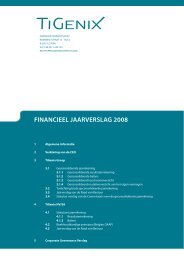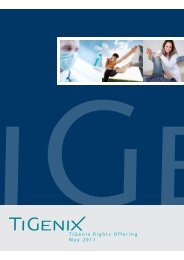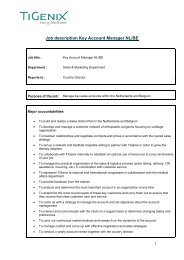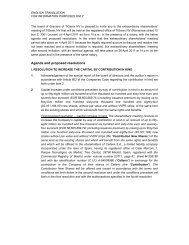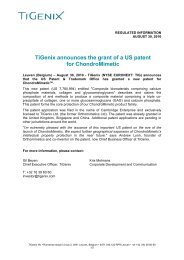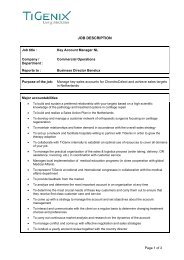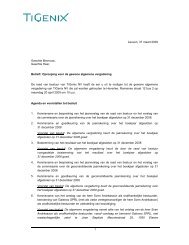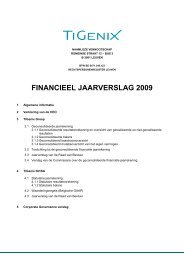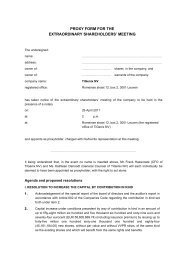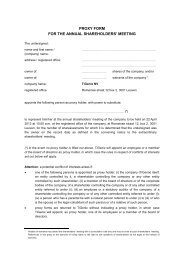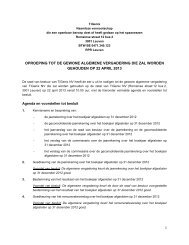ANNUAL REPORT 2012 - TiGenix
ANNUAL REPORT 2012 - TiGenix
ANNUAL REPORT 2012 - TiGenix
Create successful ePaper yourself
Turn your PDF publications into a flip-book with our unique Google optimized e-Paper software.
are at the heart of the immunomodulatory<br />
properties of eASCs. During the inflammatory<br />
process, IFN-γ is secreted by the patient’s<br />
lymphocytes. When eASCs are injected<br />
into the inflamed site, they are activated by<br />
the IFN-γ, resulting in the expression of the<br />
enzyme IDO. The enzymatic activity of IDO<br />
suppresses the proliferation of activated<br />
lymphocytes, shutting down chronic<br />
inflammation, and thereby supports a natural<br />
healing of the inflamed tissue.<br />
The second property of the eASC, secretion<br />
of repair and growth promoting molecules,<br />
is playing a role after the initial control of<br />
inflammation like in fistula healing.<br />
Expanded adipose tissue<br />
as active ingredient<br />
<strong>TiGenix</strong> has developed its platform using<br />
expanded adipose stem cells (eASC)<br />
extracted from human adipose tissue. By<br />
sourcing cells from adult adipose (fat) tissue,<br />
the company is able to capitalize on the<br />
benefits associated with this type of cells<br />
compared to other cell types (such as stem<br />
cells sourced from bone marrow). The most<br />
important advantages of this approach<br />
are : ease and amount of supply (collected<br />
through a routine liposuction); rich supply of<br />
stem cells (stem cells can represent 2 % of the<br />
total cells of the Stromal Vascular Fraction<br />
(“SVF”) of the fat tissue; a potential yield of<br />
100 to 1,000 times higher than other possible<br />
sources of stem cells; robust phenotype<br />
(eASCs do not require overly elaborate<br />
growth conditions and can be grown<br />
continuously without loss of their primary<br />
characteristics); and a good safety profile.<br />
Allogeneic approach<br />
An allogeneic (based on donor cells)<br />
treatment has a series of advantages when<br />
compared to using autologous (based on<br />
the patient’s own cells) cell products, such<br />
as :<br />
(a) Efficient production of large lots (batches)<br />
of cells :<br />
- Manufacturing scale-up can be applied<br />
- Quality control tests can be applied to<br />
larger lots, reducing cost of manufacturing<br />
- Material of high consistency (individual lots<br />
of a large batch)<br />
(b) Cells are always available :<br />
- Can address emergency indications<br />
- Allows high patient throughput<br />
- Represents a good commercial opportunity<br />
(c) No patient biopsy/tissue procurement<br />
needed :<br />
- Less clinical time and resources<br />
- Avoids taking biopsies from severely ill<br />
patients<br />
- Allow for treatment of patients who do not<br />
possess sufficient tissue or who for any other<br />
medical reason cannot undergo tissue<br />
procurement<br />
(d) Commercial product orientated :<br />
- Readily-available product<br />
60 <strong>TiGenix</strong> I annual report <strong>2012</strong><br />
- Potentially higher margins thanks to<br />
optimized product cost of goods



